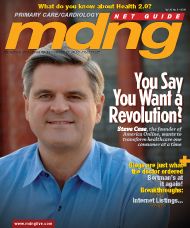Publication
Article
MDNG Primary Care
TechSectors: Medical Device - The Networked Pill
10% of hospital admissions and 23% of nursing home admissions are due to the failure of a patient to take a prescription medication correctly, and as many as 59% of those taking fi ve or more medications are taking them improperly.
Nearly 29% of Americans discontinue their medication before it runs out, 22% take less than prescribed on the label, 12% don’t take their medication after they fill a prescription, and another 12% don’t bother to fi ll the prescription at all, according to the American Heart Association. What’s more, 10% of hospital admissions and 23% of nursing home admissions are due to the failure of a patient to take a prescription medication correctly, and as many as 59% of those taking fi ve or more medications are taking them improperly. The numbers don’t lie; medication compliance is a huge issue faced by healthcare professionals.
So, imagine if a device existed that monitored when a pill was taken—not to mention its effects on the body—and transmitted that data to a physician, family member, or other caregiver. “That would be the ultimate compliance system,” says Leslie Saxon, a cardiologist at the University of Southern California and a consultant for Proteus Biomedical, a company currently developing such a system. “One of the surefire ways to track a pill is to track it after it’s ingested. If you can do that harmlessly and transmit that data somewhere, it’s a maximum use of enabling technologies.” Proteus’ new Raisin system features a pill containing an ingestible event marker (IEM)—consisting of a microchip the size of a grain of sand and a nontoxic, thin-film battery activated
upon ingestion when exposed to water—that when swallowed, sends a high-frequency electrical current using the body’s conductive tissues to conduct a signal with a modulation that provides a unique marker for the pill and which is confi ned within the body.
A receiver built into a skin patch or subcutaneous insert picks up the signal and logs it, and also senses physiological parameters like heart rate, respiration, and bodily movement. The data is then uploaded to a server via a cell phone or a computer and sent to a family member’s or physician’s mobile device or computer to be scrutinized. Doses and administration times can then be altered based on how many pills the patient is taking, what medications those pills contain, and when they are taken. “If you had a technology that for each person you could know what their heart pressure did—which is a big predictor for how heart failure patients are doing—and you also knew when they took their drug, you could really get down to creating a tailored prescription for each person,” says Saxon. “You’d know for Mrs. Jones that after she eats, she needs this or that. You could not only dose it right, but time it better.” Patients’ relatives could also be alerted when a dose was missed. “It enables that person to call up and say, ‘Mum, you forgot to take your pill today,’” said Proteus CEO Andrew Thompson.
Direct observation of patients with a contagious condition that requires constant medication monitoring, like tuberculosis, can also be drastically reduced or eliminated with the system, which achieves the same goal, but without the intrusion or potential contamination. Patients and caregivers needn’t worry about privacy issues. “The data we’ve developed inside you stays inside you unless you give permission to have it go outside you,” noted Thompson. And because the system’s signals are transmitted electrically through skin tissues, they can’t be picked up remotely, even by the receiver of another patient using the same system (even if they came into skin-toskin contact). Data that is transmitted to a caregiver, is protected by security safeguards.
Though not available yet, clinical trials in human users have begun to test functionality of the IEM and sensors, with Proteus hoping to bring the system to the market in 2011. Costs should be reasonable; when manufactured in volume, the IEMs could cost less than a penny each, according to Proteus CTO Mark Zdeblick.
“It’s a really novel, incremental, interesting technology that’s going to be tested and could be a real addition to enforcing compliance,” concludes Saxon.






